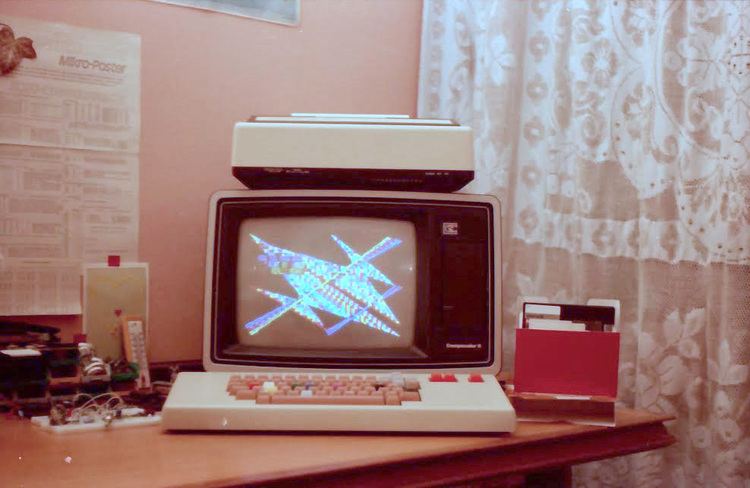Manufacturer Compucolor Corporation Retail availability 1976-1980 Operating system | Release date 1976 Units sold 1000+ CPU Intel 8080/8080A | |
 | ||
The Compucolor II was an early color home computer product introduced in 1976 by Compucolor Corporation of Norcross, Georgia USA. It was a major product breakthrough in color graphics, text, and storage.
Contents
The Compucolor II initially was available at three price points: $1,395.00 (base), $1,595.00 (Extended), and $1,795.00 (Deluxe) in USD. The price difference governed by the internal "User" memory. The "base" unit came equipped with 8 KB dynamic RAM, followed by "extended" as 16 KB, and then "Deluxe 32 KB". It was the first color home computer system with built-in color graphics, floppy based data storage, and a specialized "QWERTY"-style keyboard.
Compucolor opened its first retail computer store in Norcross, Georgia USA in 1979. It was aptly named the "Compucolor Computer Store". The store had limited success in the six months of operation, and the store concept was abandoned.
By 1983, Compucolor was out of business. Follow-on Compucolor II home/office computers were manufactured by Intelligent Systems Corporation, also of Norcross, Georgia USA.
Details
The computer and integrated monitor were built into a standard General Electric (GE) 13" color television set cabinet. These cabinets were procured without TV components and modified to house a custom set of video analog electronics, digital board, and floppy drive.
The machine was based on the Intel 8080 operating at 1.99 mHz clock rate and used a SMC CRT5027 video controller programmed to provide the 64 character by 32 line screen format. Internal proprietary ROM firmware allowed a plot graphics array of 128 H by 128 V available in 8 colors. Again, the system was sold with as User RAM in increments of 8 KB of RAM, expandable up to 16 or 32 KB.
Three available keyboards having 72 (standard), 101 (expanded), or 117 (deluxe) individual keys. which attached to the computer with a 25-pin ribbon cable. The keys were deluxe full-travel "Cherry brand" type having golden cross-bar contacts with excellent feel and reliability. Key tops were engraved with special legends to help manage computer functions.
The Compucolor II used a custom designed 51.2KB 5.25" floppy disk drive, which was placed on the right side of the monitor cabinet. The design utilized a serial interface and was referred to as the "Compucolor Drive" or "CD". There were reliability issues with this design since any variance in motor spindle speed would cause difficulty reading or writing floppy media. Also there were a few electromagnetic issues within the cabinet space that interfered with the floppy recording and read process.
The disk operating system known as "File Control System" or "FCS" was designed in-house. FCS was developed, expanded, and proven to be a viable method to store data at the time
In the case of FCS, when a file was deleted, the individual file would be "removed from the file list volume" and remaining data would be moved to fill sequential empty space, using the 4 KB portion of display video RAM as a transfer buffer memory. In modern-day terms, files would be automatically defragmented to prevent cross-linked files.
Software
A ROM-based BASIC was included as an improved and sub-licensed version of Microsoft BASIC. Compucolor Corporation took a few steps to improve BASIC. Compucolor Corporation worked closely with Microsoft Corporation, and a licensing agreement was agreed to in the best interest of both companies.
Most legally available software for the Compucolor II was written by in-house software programmers. Over 20 software titles were officially released by Compucolor with custom 5-1/4" artwork title covers: Air Raid, Othello, Blackjack, Bounce, Chess, Cubic Tic Tac Toe, Lunar Lander, Maze Master, Sharks, Shoot, Solitaire, Star Trader, Star Trip, and Swarms. There was also a groundswell of hobbyists and user groups who created software for sale or "shareware" among its groups.The most important title for the Compucolor II was probably a game called Star Trip which mimicked the Star Trek genre.
